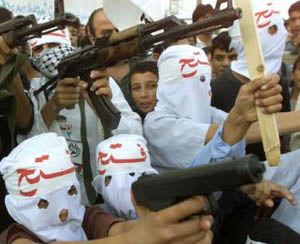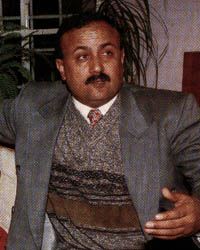 |
| Vol. 2 No. 10 | Table of Contents MEIB Main Page | November 2000 |
 |
| Members of the Tanzim at a demonstration in Gaza last month [Reuters/Reinhard Krause] |
The "Al-Aqsa Intifida" has witnessed the most intense fighting between Israelis and Palestinians in nearly two decades, with the death toll now approaching 200, mostly Palestinian, fatalities. According to the conventional wisdom, the uprising was triggered by the untimely visit of Israeli Likud leader Ariel Sharon, flanked by over 1,000 riot policemen, to the Temple Mount/Haram al-Sharif in Jerusalem on September 28. This event, it is said, sparked a familiar pattern of "spontaneous" Palestinian riots and Israeli reprisals--a self-propelling process whereby demonstrators are killed and injured, fueling public passions that result in further protests, and so forth. The uprising is attributed to the same dynamic that governed the 1987-1993 Intifada, and to a lesser extent the "tunnel riots" of 1996, with most of the debate centering around Yasser Arafat's willingness and capability to control the Palestinian "street."
But for all the destructive energy unleashed by the Al-Aqsa Intifida, the scope of popular participation has been surprisingly limited. Although large numbers of Palestinians have taken part in peaceful rallies and funeral processions, the crowds that have confronted Israeli troops with rocks and Molotov cocktails on a daily basis have been notably smaller than those that spontaneously arose during the first Intifada. What is new about the current uprising--the frequent use of firearms against Israeli soldiers and settlers--is mainly attributable to a relatively small number of Fatah activists, numbering perhaps a few hundred at most.
The geographic and demographic dimensions of the current uprising are telling. The bloodiest confrontations, accounting for around half of Palestinian fatalities, have taken place in Ramallah and Nablus--the main strongholds of the Tanzim, the armed wing of Yasser Arafat's Fatah movement led by Marwan Barghouti, and the intensity of confrontations elsewhere is largely reflective of the group's strength in particular areas. In places where this organizational component is lacking, Palestinians have been remarkably unwilling to riot. Residents of East Jerusalem, for example, have not participated in large numbers (though "imported" activists from the surrounding territories have engaged Israeli police), nor have people living in the Christian sectors of Bethlehem (this despite a concerted effort by the Tanzim to provide the world with "Christian" martyrs). Rural areas of the West Bank, which constituted the "heart and soul" of the first Intifada, have sat this one out.
This is not to say that popular sentiments have not played a role in fueling the uprising (more on this below), only that the locations and timing of confrontations reveal an element of hierarchical decision-making. The question of causality is centered around the question of who is "in charge" of the Palestinian street.
It is clear that, whatever the immediate causes of the revolt may have been, the Tanzim initially assumed control over its direction with Arafat's approval. Two steering committees were established in the West Bank and Gaza, meeting secretly every night of the uprising to set the times and locations of demonstrations for the next day. In an effort to minimize unauthorized protests and attacks against Israelis, representatives of the Hamas, Islamic Jihad and other militant groups were permitted to attend and take part in these committee meetings. This strategy of coopting Islamist and other extremist groups was successful at first. Hamas, in fact, appears to have taken few independent actions of its own during the first weeks of the uprising--for this it was apparently rewarded by the release of 85 Islamists by the Palestinian Authority (PA) on October 12.
 |
| Marwan Barghouti |
Most of the major armed attacks against Israelis during the uprising have been conducted by members of the Tanzim. During the first two weeks of the uprising, the Tanzim operated in coordination with PA officials, or at least with their tacit approval--the assault on Joseph's tomb, for instance, was a premeditated operation that lasted for several days and took place in close proximity to PA security forces stationed in Nablus. A clear trend emerged whereby Arafat and senior PA officials mounted claims of "plausible deniability" for the attacks while simultaneously offering to rein in the militia in return for Israeli concessions. The Palestinian chief of Preventive Security Services, Muhammad Dahlan, told Radio Palestine on October 16 that the PA would not disarm Tanzim militants until Israel had disarmed Jewish settlers living in the occupied territories.
However, when Arafat returned from the Sharm al-Sheikh summit and instructed the heads of Palestinian security organizations to enforce the cease fire negotiated under American auspices, it soon became clear that Barghouti was exerting more control of the uprising than the PA leadership and that he had no intention of calling it off. Barghouti publicly declared that the Intifida "will continue until the attainment of sovereignty and independence" and hinted that Arafat lacked the power to stop it. "This intifada has laid down a new rule: Let those who want to negotiate do so, but the Palestinian people will continue their struggle," he added defiantly. "We will no longer be captives of the negotiating table."1 On October 19, Tanzim militiamen opened fire on Israeli settlers and a group of their supporters near Nablus, triggering a gun battle that left one Israeli and one Palestinian dead. When a squad of PA policemen arrived to enforce the cease fire and permit the evacuation of the Israelis, the Tanzim gunmen opened fire on them and the police withdrew. Asked about his conditions for an end to the Intifida in an interview days later, Barghouti replied that "all Jewish settlements must be eliminated. Otherwise, no real peace is possible."2
This tension between Arafat and Barghouti is first and foremost indicative of a long-standing, struggle for power between the "outsiders"--the exiled PLO leadership in Tunis that accompanied Arafat to the occupied territories in 1994 and assumed most senior positions in the PA--and the "insiders"--grassroots activists who spent their lives fighting the Israeli occupation from within and took charge of the 1987-1993 Intifada. The increasingly authoritarian nature of Arafat's rule and endemic corruption within the PA have led to intense popular disaffection that each side has sought to exploit in pursuit of its political objectives.
The contention that this growing public disaffection is fueled by insufficient Israeli concessions at the negotiating table is highly questionable. The concessions made by Barak at the Camp David summit in July were unprecedented: relinquishing over 90% of the West Bank, permitting the return of some refugees to Israel proper, giving the Palestinians sovereignty over the Christian and Muslim quarters of Jerusalem's Old City, and allowing the PA to have administrative control over the Temple Mount (Haram al-Sharif). That these offerings are insufficient in the eyes of most Palestinians is undeniably true, but it is also true that none of the Palestinian officials involved in the Oslo Accords ever imagined that Israel would agree to concessions of this magnitude. Arafat and his colleagues were repeatedly told by the Americans from the very beginning of the peace process that "painful sacrifices" would have to made. No one in a position of authority around Arafat in 1993 seriously entertained the notion that Israel could be persuaded in the course of peaceful negotiations to satisfy all Palestinian demands.
The assumption underlying the Oslo Accords was that the Palestinian leadership would work during the interim period to prepare the Palestinian public for a compromise settlement with Israel. Economic prosperity, it was thought, would be the engine of this process and international donors enthusiastically lined up to provide the fuel. Seven years later, however, economic conditions for most Palestinians have deteriorated and no one seriously disputes that corruption in the PA is the main factor responsible for this. Arafat's top lieutenants have profited handsomely from the billions of dollars in economic aid that were injected into the Palestinian economy and they have not been particularly discrete about it--ostentatious displays of wealth amid widespread poverty are a recipe for disaster. Thus, it is not surprising that many Hamas activists released from PA prisons in Gaza last month celebrated their new-found freedom not by searching for Israelis to kill, but by ransacking and burning nightclubs operated by Arafat's cronies (they were quickly taken back into custody).
That public disaffection concerning a range of domestic grievances are projected onto Israel is not really surprising when one considers the political conditions that obtain under Arafat's rule. When the only acceptable reason for demonstrating publicly is criticism of Israel, the issue becomes a channel for vicariously expressing outrage at the authorities. Participants in the most violent demonstrations have consisted mostly of young men from refugee camps with little at stake in Arafat's rule.
For Arafat, then, the problem may be not that the Palestinian "street" is unwilling to countenance a compromise settlement with Israel, but that the Tanzim is unwilling to back a settlement that will entrench his authority and is capable of perpetuating violent demonstrations at the grassroots level that make a negotiated settlement impossible. On several occasions in recent weeks, Arafat has attempted to dampen the rioting by ordering businesses in the West Bank to reopen, only to find the Tanzim dispatching "enforcers" with Ak-47's to close them down again. "I believe that more than 90 percent of the Palestinians are not interested in an open military conflict with Israel," a prominent Palestinian academic told an American reporter last month. "But their voices are not heard because at present it is the militants who control the streets."3
Arafat's attempts to obstruct the Tanzim have been intermittent and half-hearted, however, because the inevitable failure of these initiatives only serve to expose his own political weakness. In any case, while Arafat's refusal to confront the Tanzim may have stemmed the decline in popular support for the PA, it threatens to permanently alienate Israeli and American officials whom he needs to sign off on an independent Palestinian state.
Notes
1 Al-Jazira Satellite TV (Doha), 17 October 2000.
2 Der Spiegel (Hamburg), 23 October 2000.
3 U.S. News & World Report, 30 October 2000.